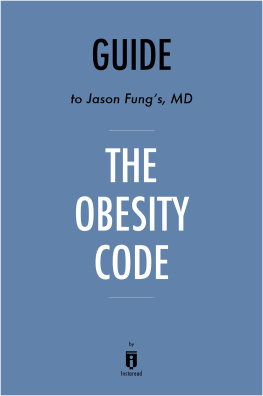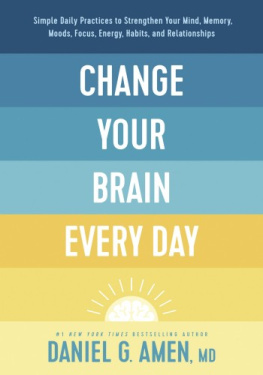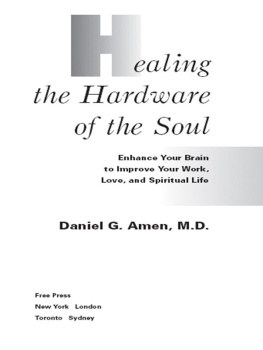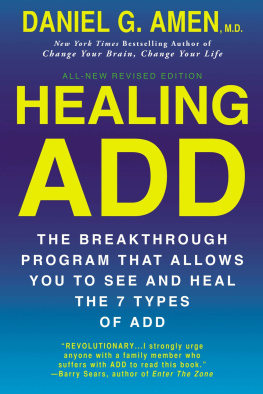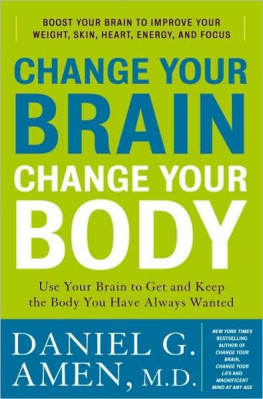Guide to
Daniel G. Amens, MD
Change Your Brain, Change Your Life
The Breakthrough Program for Conquering Anxiety, Depression, Obsessiveness, Lack of Focus, and Memory Problems
by
Instaread
Please Note
This is a companion to the original book.
Copyright 2016 by Instaread. All rights reserved worldwide. No part of this publication may be reproduced or transmitted in any form without the prior written consent of the publisher.
Limit of Liability/Disclaimer of Warranty: The publisher and author make no representations or warranties with respect to the accuracy or completeness of these contents and disclaim all warranties such as warranties of fitness for a particular purpose. The author or publisher is not liable for any damages whatsoever. The fact that an individual or organization is referred to in this document as a citation or source of information does not imply that the author or publisher endorses the information that the individual or organization provided. This concise companion is unofficial and is not authorized, approved, licensed, or endorsed by the original books author or publisher.
Table of Contents
Overview
Change Your Brain, Change Your Life by psychiatrist Daniel D. Amen is a non-fiction book based on the idea that brain functioning can be improved, and such improvement can drastically change lives for the better. Amens approach to healing the brain is based on more than 100,000 scans he and his colleagues have conducted at the Amen Clinics, a medical facility that adopts an integrated approach to brain health. Amens methodology centers on the pioneering use of brain imaging utilizing single photon emission computed tomography, or SPECT, as well as appropriate treatment and brain-boosting habits. The results of this approach are increased happiness and success, improved relationships, and greater levels of health.
The brain is the organ that governs every facet of human consciousness, including how we talk, feel, learn, create, move, relate, behave, and comprehend and respond to the world around us. To gain a clearer picture of brain function, some doctors and researchers use SPECT imaging to reveal brain activity and blood flow and create a comprehensive picture of the brain. Unlike an MRI (magnetic resonance imaging) or CT (computed tomography) scan, SPECT imaging shows where theres either too much or too little activity in the different sectors of the brain. SPECT analysis also shows whether or not there has been a traumatic brain injury or infection thats harming the brain. Patients who suffer from certain medical conditions, such as depression, post-traumatic stress disorder (PTSD), and attention deficit disorder (ADD), can visually see where they are deficient and learn how to address their specific brain needs through medication and supplements, as well as psychological, behavioral, and spiritual interventions. Blanket diagnoses often do not work because they dont take the individuals specific conditions into account; frequently, there are overlapping problems in different areas of the brain. SPECT analysis has yielded several subsets of various conditions. For example, there are seven types of anxiety and depression, six types of addiction, and five types of overeating.
Having a visual picture of a healthy brain can inspire brain envy and encourage patients to be proactive about adopting new behaviors and approaches that will have a lasting impact on their brain, which in turn improves health, relationships, and overall quality of life.
Change Your Brain, Change Your Life, a New York Times bestseller, was first published by Harmony Press in 1999.
Important People
Daniel G. Amen is a psychiatrist and ten-time bestselling New York Times author. He is the founder and CEO of Amen Clinics. Amen makes frequent national media appearances and has produced television programs for the Public Broadcasting Service (PBS).
Key Insights
- Using SPECT imaging helps decrease the stigma associated with a range of conditions, such as depression and compulsive thinking, by understanding them through a medical rather than a moral framework.
- By taking responsibility for our brain health, we can increase brain reserves to combat the natural aging process and address other health conditions.
- There are four circles of brain health that should be addressed in every patient: biological, psychological, social, and spiritual. This integrated approach helps ensure that patients will be treated holistically.
- The limbic system (LS) sets an emotional tone, stores highly charged memories, and promotes bonding. Signs of LS imbalance include excessive sadness and pessimism.
- The basal ganglia (BG) system helps integrate feelings, thoughts, and movement and is involved in forming habits. Signs of BG imbalance include anxiety and a habit of expecting the worst.
- The prefrontal cortex (PFC) is the most evolved part of the brain and acts as an executive decision-maker, invoking logic, planning skills, and impulse control. Signs of PFC imbalance include short attention span, poor judgment, disconnection from emotion, and ADD.
- The anterior cingulate gyrus (ACG) is responsible for flexibility and adaptability. Signs of ACG imbalance include worrying, being stuck in the past, and obsessive or compulsive thoughts.
- The temporal lobes (TL) rule long-term memories, language, and social cues. Signs of TL imbalance include aggression, violent thoughts, and emotional instability.
Analysis
Key Insight 1
Using SPECT imaging helps decrease the stigma associated with a range of conditions, such as depression and compulsive thinking, by understanding them through a medical rather than a moral framework.
Analysis
A socialized belief about psychological and behavioral problems holds that individuals have a certain degree of control or free will regarding their choices. If a person has cardiovascular disease , for example, that is generally accepted to be a physiological condition, whereas theres still an intense shame associated with brain-related disorders even though they are also physiologically based conditions. SPECT imaging helps family members and patients accept the idea that mood swings and erratic behavior actually have biological roots . This increases c ompassion for those who are suffering and improves their relationships with other people.
In 2015, author Diana Spechler, who has suffered from anxiety and depression, decided to do an experiment: she tapered off her psych meds and chronicled the process in an ongoing column for The New York Times. For five months, she wrote weekly dispatches about the process of weaning herself off her antidepressant, sleeping pill, and anxiety medicine. The response to her column was overwhelmingand overwhelmingly mixed. While many wrote in support of her journey, another considerable number of readers wrote in to criticize Spechler for her choices. Some even suggested that she was whining about her situation. [1] This response underscores the perception that individuals suffering from mental illness have a certain degree of control over their condition, when, in fact, depression has a biological and medical basis.
Mike Webster, a former Pittsburgh Steelers player, is another example of someone whose behavior was not initially understood to be a medical condition. Webster became the first documented case of chronic traumatic encephalopathy (CTE), a degenerative brain disease that was only documented after he died of a heart attack in 2002. He had been subject to mood swings, angry outbursts, and extreme behavior, such as buying a Taser gun to control the shakes that he had developed. At the time, his family didnt understand that his condition was the direct result of traumatic brain injury that he had experienced as a pro football player. Since he was unable to get proper help, his relationships suffered immensely. [2] Using SPECT imaging scans is one way of slowly changing the culture of judgment and opprobrium around brain-related dysfunction.
Next page




